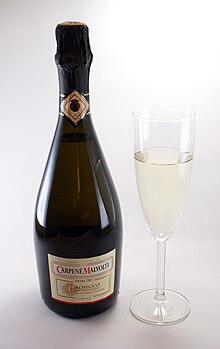Our website is made possible by displaying online advertisements to our visitors.
Please consider supporting us by disabling your ad blocker.
Prosecco

Prosecco (/prəˈsɛkoʊ, proʊ-/,[1][2] Italian: [proˈsekko]) is an Italian DOC or DOCG white wine produced in a large area spanning nine provinces in the Veneto and Friuli-Venezia Giulia regions, and named after the village of Prosecco, in the province of Trieste, Italy.[3] It is made from the Prosecco grape (renamed "Glera" in Italy in 2009), but denomination rules allow up to 15% of the wine to be other permitted varieties.[4] Prosecco is almost always made in sparkling or semi-sparkling style (spumante and frizzante, respectively), but a still wine (tranquillo) is also permitted.[5] Within the larger designation are two small DOCG areas, Conegliano Valdobbiadene Prosecco in the hills between the comuni (municipalities) of Conegliano and Valdobbiadene, and Asolo Prosecco around the nearby comune of Asolo.[6][7] Prosecco Superiore is always spumante and comes only from these DOCG areas.[8]
In 2019, Le Colline del Prosecco di Conegliano e Valdobbiadene became a UNESCO World Heritage Site, in large part due to the region's role in the production of Prosecco.[9][10] Since 2020, the DOC rules allow a rosé variety of Prosecco designated spumante rosé, which must contain Glera blended with 10–15% Pinot nero.[11]
- ^ "Prosecco". Lexico UK English Dictionary. Oxford University Press. Archived from the original on 16 April 2020.
- ^ "Prosecco". Merriam-Webster.com Dictionary. Merriam-Webster. Retrieved 22 January 2016.
- ^ Cortese, Amy (26 December 2008). "Italian Makers of Prosecco Seek Recognition". The New York Times. Retrieved 28 December 2008.
- ^ Robinson, J.; Harding, J.; Vouillamoz, J. (2012). Wine Grapes: A Complete Guide to 1,368 Vine Varieties, Including Their Origins and Flavours. Allen Lane. pp. 102–103, 853–854. ISBN 978-1-846-14446-2.
- ^ "Prosecco Types". Consorzio di Tutela delle Denominazione di Origine Controllata Prosecco. Archived from the original on 16 April 2020. Retrieved 14 April 2020.
- ^ "Conegliano Valdobbiadene Prosecco DOCG »". Italian Wine Central. Retrieved 30 November 2019.
- ^ "Asolo Prosecco DOCG". Italian Wine Central. Retrieved 30 November 2019.
- ^ O'Keefe, Kerin (25 September 2015). "The Superiority of Prosecco Superiore". Wine Enthusiast.
- ^ Kennedy, Rachel; Chadwick, Lauren (9 July 2019). "Italy's Prosecco hills receive UN world heritage status". Euronews. Retrieved 9 July 2019.
- ^ Centre, UNESCO World Heritage. "Two cultural sites added to UNESCO's World Heritage List". UNESCO World Heritage Centre. Retrieved 9 July 2019.
Le Colline del Prosecco di Conegliano e Valdobbiadene (Italy) – located in north-eastern Italy, the site includes part of the vinegrowing landscape of the Prosecco wine production area. The landscape is characterized by 'hogback' hills, ciglioni—small plots of vines on narrow grassy terraces—forests, small villages and farmland. For centuries, this rugged terrain has been shaped and adapted by man. Since the 17th century, the use of ciglioni has created a particular chequerboard landscape consisting of rows of vines parallel and vertical to the slopes. In the 19th century, the bellussera technique of training the vines contributed to the aesthetic characteristics of the landscape.
- ^ "Mipaaf". 28 October 2020.
Previous Page Next Page


